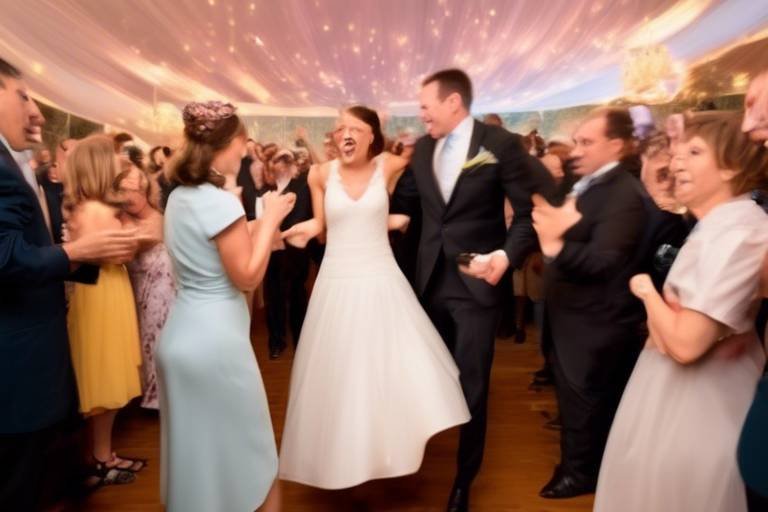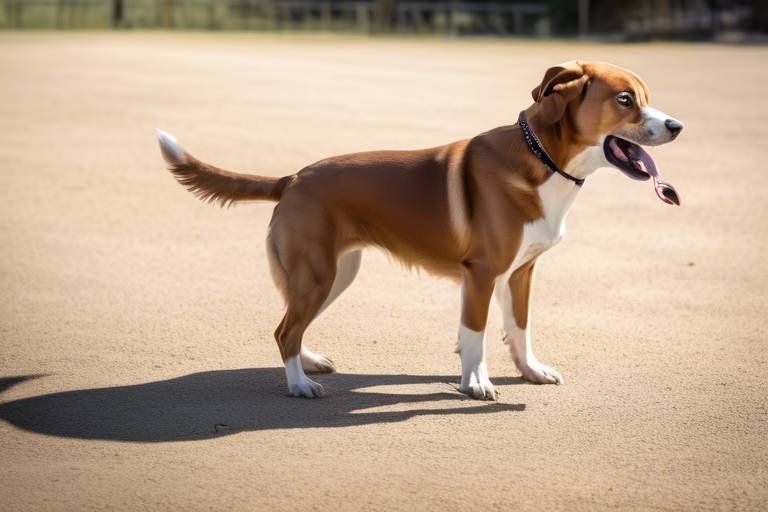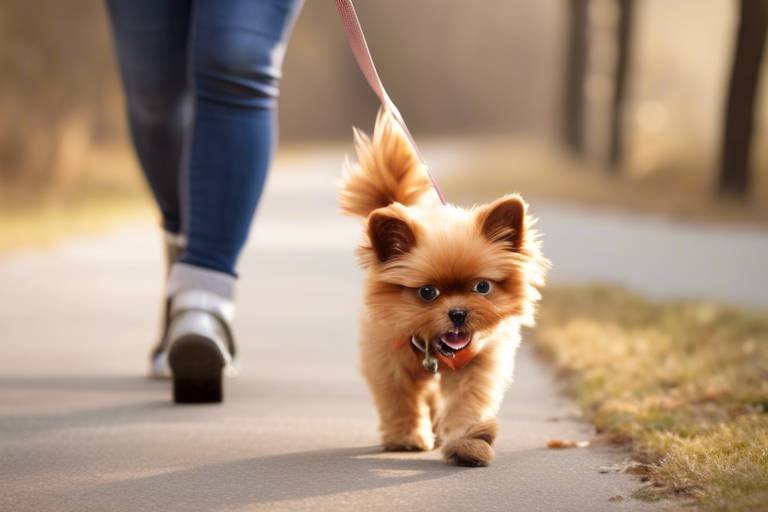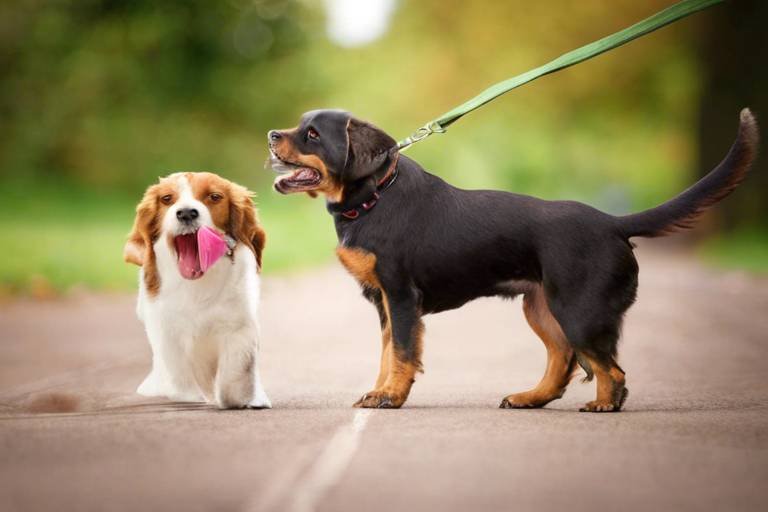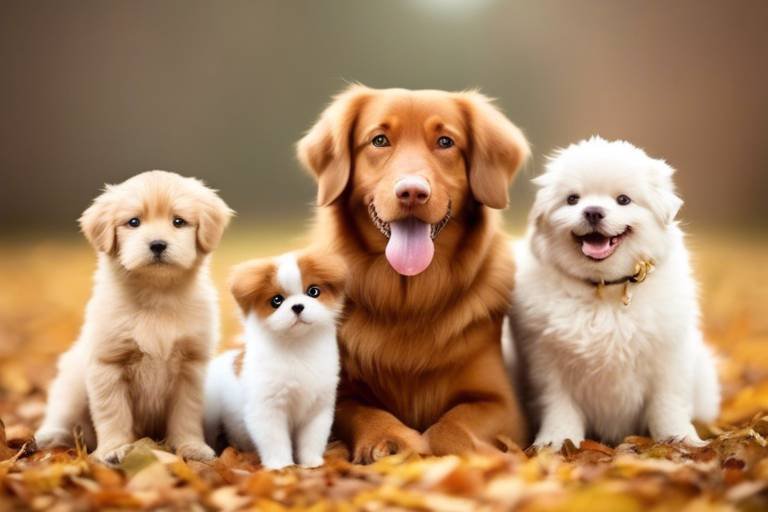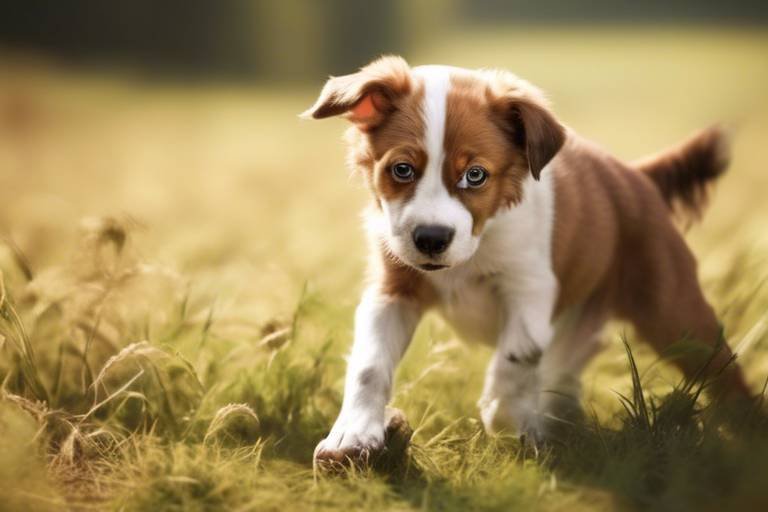How to Recognize and Correct Jumping on Guests
Dogs are often seen as man's best friend, but their enthusiastic greetings can sometimes lead to awkward moments, especially when they jump on guests. This behavior, while often harmless, can be a nuisance and may even cause discomfort for visitors. Understanding the reasons behind this exuberant greeting is the first step in correcting it. Dogs jump on guests primarily as a way to express excitement and affection, but it can also stem from anxiety or a desire for attention. Recognizing these underlying motivations can help you address the behavior effectively and create a more pleasant environment for both your furry friend and your guests.
When your dog jumps on guests, it’s important to realize that they are not being rude; they are simply excited to see new people! This jumping behavior is often a learned response, reinforced by the attention they receive from both you and your visitors. Think of it like a child who jumps in excitement when they see their favorite toy. However, just like we teach children about appropriate behavior, it’s essential to guide our dogs in understanding how to greet people without jumping. By identifying the reasons behind this behavior, you can develop a tailored approach to training that resonates with your dog’s unique personality.
Implementing effective training techniques is crucial for correcting jumping behavior. One of the most successful methods involves positive reinforcement. This means rewarding your dog with treats, praise, or affection when they greet guests calmly instead of jumping. For example, when a guest arrives, you can instruct your dog to "sit" and reward them for obeying. This not only teaches them the desired behavior but also helps them associate calmness with positive outcomes. Remember, training is not just about correcting unwanted behavior; it's about teaching your dog what you expect from them.
Utilizing positive reinforcement is a powerful tool in your training arsenal. Dogs respond well to rewards, and by offering treats and praise for calm behavior, you create a positive learning environment. Whenever your dog remains seated or stays calm while a guest enters, shower them with affection or give them a treat. Over time, this will help them understand that remaining calm is the best way to greet people. It’s like giving them a gold star for good behavior!
Establishing clear rules about how your dog should interact with guests is equally important. Consistency is key—everyone in your household should follow the same rules regarding guest interactions. For instance, if jumping is unacceptable, make sure everyone reinforces this by not giving attention to your dog when they jump. Instead, wait for them to calm down before acknowledging them. This unified approach sends a strong message to your dog about what is expected of them.
Timing is crucial when it comes to training your dog. Providing immediate feedback reinforces learning. If your dog jumps and you scold them after they have already received attention, they won't connect the action with the consequence. Instead, if you immediately redirect them or ignore the jumping, they will begin to understand that this behavior does not yield the desired response. Consistency from all family members ensures that your dog receives a unified message, which is essential for effective training.
Redirecting your dog’s energy can also be an effective strategy. Teaching them to perform alternative behaviors, such as sitting or staying when guests arrive, can channel their excitement appropriately. For instance, if you know a guest is coming over, you can have your dog sit and reward them for doing so. This not only helps in managing their excitement but also reinforces calm behavior as a norm during such interactions.
Providing regular socialization opportunities for your dog is essential in reducing jumping behavior. Exposure to various people and environments can help alleviate anxiety and excitement. Think of it as giving your dog a crash course in social etiquette! The more they experience different situations, the more comfortable they will become. This can lead to calmer behavior around guests, making visits more enjoyable for everyone involved.
Organizing controlled introductions with friends or family can be a great way to practice greeting behaviors in a manageable setting. This allows your dog to learn how to interact positively without the chaos of unexpected visitors. Start with a calm environment, and gradually introduce new people, rewarding your dog for appropriate behavior. It’s like rehearsing for a big performance—practice makes perfect!
Gradual exposure to new people can also desensitize your dog to the excitement of guests arriving. Instead of overwhelming them with a large group of visitors, start with one or two people and gradually increase the number over time. This slow approach helps your dog adjust to new situations without becoming overly excited, reducing the likelihood of jumping behavior in the future.
Creating a calm environment during guest visits is vital in setting the tone for interactions. Techniques such as pre-visit exercise or establishing designated quiet areas can significantly contribute to a more relaxed atmosphere. Think of it as preparing for a peaceful gathering—everyone benefits when the environment is serene and inviting.
Ensuring that your dog receives ample exercise before guests arrive can help reduce excess energy. A good walk or play session can tire them out, making them less likely to jump when visitors come to the door. It’s like a child who has just had a long day at the park; they are much calmer when they return home!
Establishing designated relaxation spots for your dog during guest visits allows them to feel secure and calm. Creating a cozy corner with their favorite blanket or toy can provide a familiar space for them to retreat to when they feel overwhelmed. This helps minimize the urge to jump on arriving guests, leading to a more harmonious atmosphere.
- Why do dogs jump on guests? Dogs often jump as a form of greeting or to seek attention. It’s their way of expressing excitement!
- How can I stop my dog from jumping? Use positive reinforcement techniques, set clear boundaries, and redirect their energy to more appropriate behaviors.
- Is jumping a sign of aggression? Not necessarily. Jumping is usually a friendly behavior, but it’s important to monitor your dog’s body language for signs of stress or anxiety.
- How long will it take to train my dog not to jump? Training varies for each dog, but with consistency and patience, you can see improvements within a few weeks.
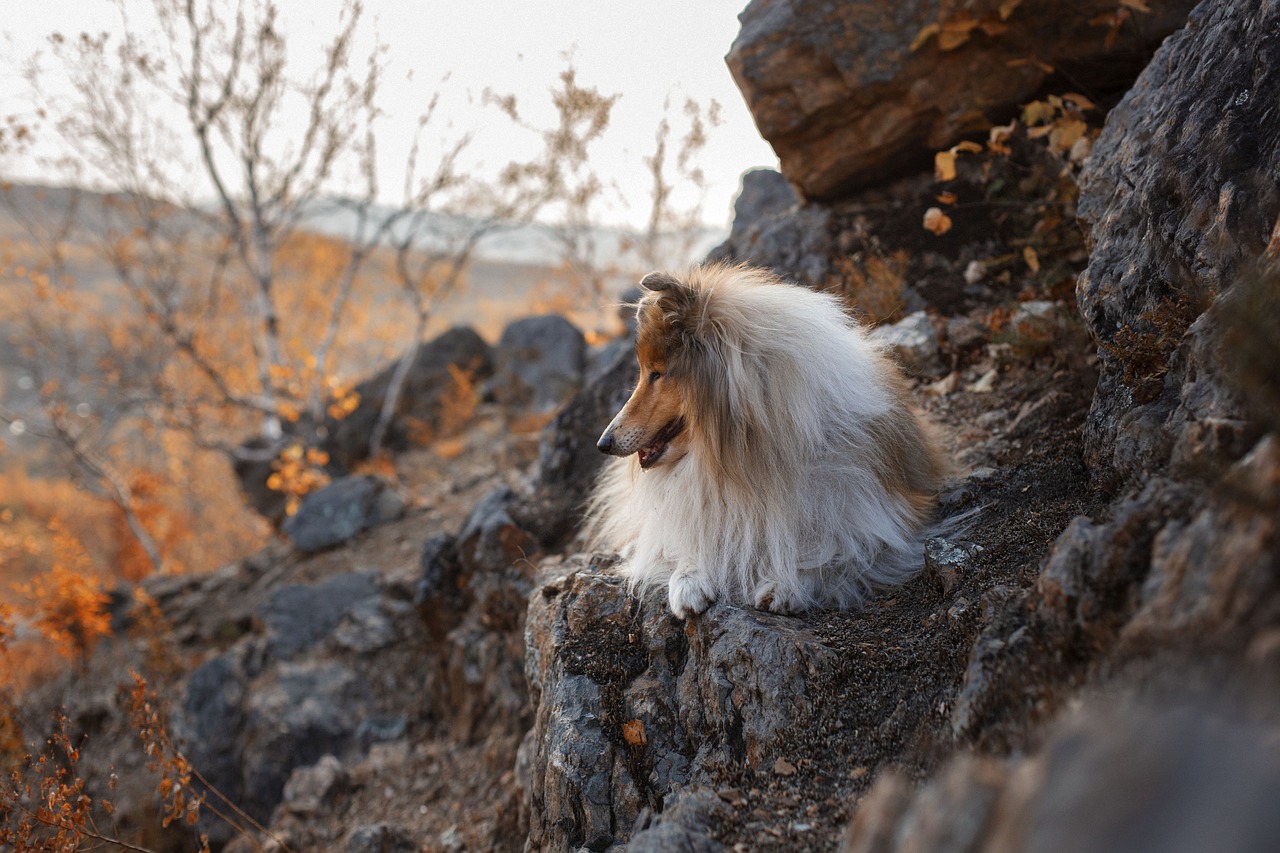
Understanding the Behavior
Dogs are social creatures, and their instinctual behavior often leads them to jump on guests as a form of greeting. Imagine a dog as a little ball of joy, bursting with excitement at the sight of a new friend. This behavior can be attributed to several factors, including their natural instincts, previous experiences, and the desire for attention. When a dog jumps, it may be trying to convey its enthusiasm, much like a child would when they see someone they adore. However, while this exuberance is endearing, it can also be overwhelming for guests who may not be accustomed to such a warm welcome.
Understanding why dogs jump on guests is the first step in addressing this behavior effectively. Here are some common reasons:
- Excitement: Dogs often jump when they are excited, especially when they see someone they recognize or a new visitor.
- Attention-Seeking: Dogs quickly learn that jumping can elicit attention from their humans, whether it's positive or negative. This reinforces the behavior.
- Greeting Behavior: In the canine world, jumping is a common greeting behavior, akin to how they would interact with other dogs.
- Curiosity: New guests often bring new scents and sounds, sparking a dog's curiosity and prompting them to jump closer for a better look.
While these reasons are rooted in instinct, it’s important to remember that not all guests may appreciate a dog’s enthusiastic welcome. Understanding the underlying motivations behind this behavior allows pet owners to develop effective strategies to manage it. For instance, recognizing that a dog jumps out of excitement can help owners redirect that energy into more appropriate behaviors, such as sitting or staying. By doing so, owners can create a more pleasant environment for everyone involved.
Moreover, addressing jumping behavior is not just about curbing a single action; it’s about fostering better communication between the dog and its human counterparts. When a dog learns to greet guests in a calmer manner, it enhances the overall experience for both the pet and the visitor. This understanding paves the way for training techniques that can effectively modify this behavior, ensuring that each interaction is enjoyable and stress-free.
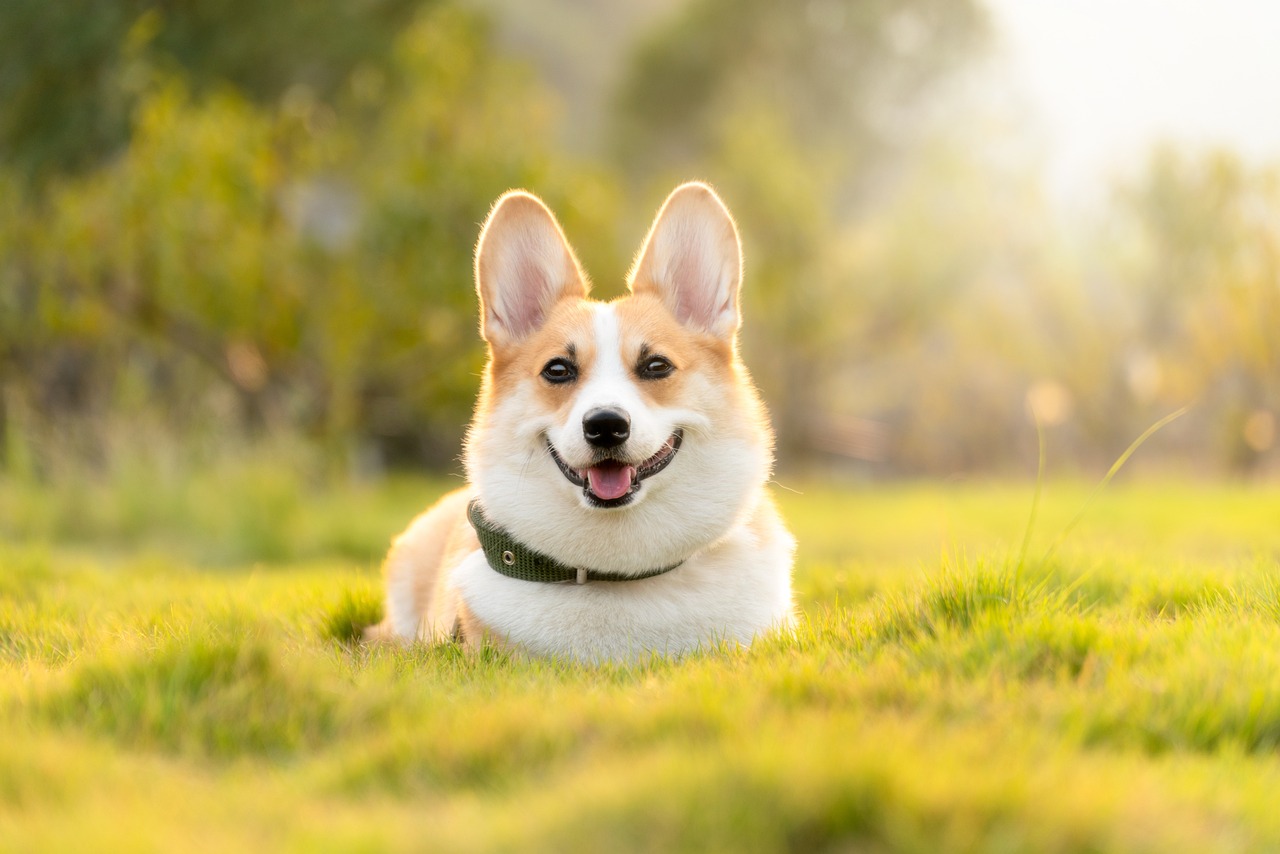
Training Techniques
Implementing effective is crucial for correcting the jumping behavior of dogs when guests arrive. This not only enhances the experience for visitors but also fosters a more harmonious relationship between pets and their owners. One of the most effective approaches is to use positive reinforcement, which involves rewarding your dog for displaying desirable behaviors. Instead of punishing your furry friend for jumping up, focus on teaching them what to do instead. For instance, when a guest arrives, you can encourage your dog to sit or stay by offering treats or praise when they follow your command. This way, your dog learns that remaining calm is more rewarding than jumping up.
Another essential aspect of training is setting clear boundaries. Dogs thrive on consistency and clarity. Establishing rules about how to interact with guests can help your dog understand when jumping is unacceptable. For example, you might decide that your dog must remain in a specific spot until they are invited to greet the guest. This not only teaches them to control their excitement but also reinforces the idea that good behavior is expected. Remember, consistency is key; all family members should enforce these rules to ensure the dog receives a unified message.
Timing and consistency play a significant role in effective training. Providing immediate feedback when your dog displays the desired behavior reinforces learning. For instance, if your dog sits calmly as the guest arrives, reward them right away to connect the action with the positive outcome. Similarly, if they jump, gently guide them back to a sitting position without yelling or showing frustration. This method helps them understand what is expected. It’s important that all family members respond consistently to your dog’s behavior, as mixed signals can confuse them and hinder their training progress.
Additionally, redirecting energy can be a game-changer in managing jumping behavior. Dogs are naturally energetic and excited, especially when they see new people. By teaching them alternative behaviors, such as going to their designated spot or performing a trick when guests arrive, you can channel that energy productively. When a guest comes over, you might have a command ready that asks your dog to "go to your mat" or "fetch a toy." This not only distracts them from jumping but also keeps them engaged in a positive way.
In summary, the key to correcting jumping behavior lies in a combination of positive reinforcement, clear boundaries, timely feedback, and energy redirection. By implementing these training techniques, you can create a more pleasant environment for both your dog and your guests, leading to enjoyable interactions every time someone comes through the door.
Positive Reinforcement
When it comes to training our furry friends, stands out as one of the most effective techniques, especially for curbing unwanted behaviors like jumping on guests. Imagine your dog as a sponge, soaking up everything you teach them. By using treats and praise, you can guide them toward the behaviors you want to encourage. Instead of scolding your pup for jumping, which can lead to confusion and anxiety, reward them when they keep all four paws on the ground. This creates a clear connection in their mind: calm behavior equals rewards!
To implement this method effectively, begin by preparing a stash of your dog's favorite treats. When a guest arrives, ask your dog to perform a simple command, such as sit or stay. If they comply, shower them with praise and a treat. This not only reinforces the desired behavior but also helps them associate the arrival of guests with something positive. It's like throwing a little party every time someone walks through the door!
Consistency is key in this process. Make sure that everyone in your household is on the same page regarding training. If one person allows jumping while another discourages it, your dog will become confused. Therefore, create a training plan that everyone can follow. For instance, if a guest enters your home, you might establish a rule that the dog must sit and stay in a designated area until they are invited to greet the visitor. This not only helps your dog learn the right behavior but also makes your guests feel more comfortable.
Another essential aspect of positive reinforcement is timing. The moment your dog performs the desired behavior, reward them immediately. This immediate feedback is crucial as it helps your dog make the connection between their actions and the reward. Think of it as a light bulb moment for them; they realize that staying calm leads to treats and affection. Over time, this will encourage them to choose calmness over chaos when guests arrive.
In summary, incorporating positive reinforcement into your training routine can transform your dog's behavior. By rewarding them for staying calm and composed during guest visits, you not only help them learn but also create a more enjoyable environment for everyone involved. So, the next time your doorbell rings, remember to grab those treats and get ready for some tail-wagging success!
- What is positive reinforcement? Positive reinforcement is a training technique that involves rewarding desired behaviors to encourage them to be repeated.
- How long does it take for a dog to learn not to jump? The time it takes can vary based on the dog's age, temperament, and consistency of training, but with patience, significant improvements can often be seen within a few weeks.
- Can positive reinforcement be used with other behaviors? Absolutely! This method is effective for a wide range of behaviors, from basic commands to more complex tricks.
Setting Clear Boundaries
Establishing clear boundaries for your dog when it comes to interactions with guests is essential for curbing the jumping behavior. Think of it like setting the rules for a game; without them, chaos ensues, and nobody enjoys the experience. By defining what is acceptable and what is not, you create a framework that helps your furry friend understand their role during guest visits. It’s crucial to be consistent with these boundaries, as dogs thrive on routine and predictability.
To begin with, you might want to designate a specific area where your dog can greet guests, such as a designated greeting zone. This could be a mat or a specific spot in the room where they are allowed to welcome visitors. By doing this, you are not only teaching them where to go but also providing them with a sense of security. If they jump outside this area, they should receive a gentle reminder to return to their spot. Remember, positive reinforcement is key here; praise them when they stay put!
Moreover, it's important to communicate these rules to everyone in your household. If one person allows the dog to jump while another discourages it, the mixed signals can confuse your pet. Consistency is vital; everyone should be on the same page regarding how to handle guest interactions. You might even consider creating a simple chart or table to outline the rules for your family, ensuring that everyone understands their role in reinforcing these boundaries.
| Rule | Action |
|---|---|
| Stay in the designated area | Reward with treats and praise |
| No jumping on guests | Redirect to a sit or stay command |
| Calm greetings only | Use a calming voice and body language |
Lastly, patience is paramount. Setting boundaries is not an overnight fix; it takes time for your dog to learn and adapt to these new rules. Celebrate small victories along the way, and don't be discouraged by setbacks. Just as we all need time to adjust to new norms, so do our furry companions. With patience, consistency, and a little love, you’ll be well on your way to a more pleasant experience for both your guests and your dog.
- How long does it take to train my dog not to jump on guests? Training times can vary based on the dog’s age, temperament, and previous experiences. Generally, with consistent practice, you may start seeing improvements within a few weeks.
- What should I do if my dog continues to jump despite training? If jumping persists, consider consulting a professional dog trainer who can provide tailored strategies to address the behavior.
- Are there specific breeds that jump more than others? Yes, some breeds are naturally more excitable and tend to jump more, such as Labrador Retrievers and Border Collies. Understanding your dog’s breed can help set realistic expectations for training.
Timing and Consistency
When it comes to training your dog to stop jumping on guests, timing and consistency are everything. Imagine you’re at a concert, and the band is playing your favorite song. If the music stops abruptly, you might feel a bit lost, right? That’s how dogs feel when they don’t receive immediate feedback during training. Providing feedback right after a behavior, whether it’s jumping or sitting, helps your furry friend connect the dots. For example, if your dog jumps on a guest and you only scold them after they’ve already landed, they might not understand what they did wrong. Instead, if you gently redirect them the moment they leap, they start to grasp the idea that jumping isn’t the way to say hello.
Consistency is equally crucial. Just like a child needs clear rules to thrive, dogs thrive on predictable responses. If one family member allows the dog to jump while another reprimands them, it creates confusion. To avoid mixed signals, everyone in the household should be on the same page. This means establishing a unified approach to training. You might even consider creating a simple chart (see below) to keep track of who is responsible for which training techniques, ensuring that everyone is aligned in their efforts.
| Family Member | Training Technique |
|---|---|
| Mom | Redirect to sit |
| Dad | Use treats for calm behavior |
| Child | Practice with friends |
Incorporating both timing and consistency into your training routine will not only help your dog learn faster but will also foster a more harmonious environment when guests come over. Remember, dogs are creatures of habit, and the more consistent you are, the more likely they are to develop good habits. So, the next time your doorbell rings, you’ll be ready to greet your guests with a calm and collected pup—no jumping required!
- Why does my dog jump on guests? Dogs often jump as a way to greet people, express excitement, or seek attention.
- How long does it take to correct jumping behavior? The time varies by dog, but with consistent training, you can see improvements within a few weeks.
- Can I train my dog not to jump on guests without treats? Yes, while treats are effective, you can also use praise, toys, and play as rewards.
- What should I do if my dog jumps on someone? Redirect your dog immediately to a sit or stay command, and reward them for calm behavior.
Redirecting Energy
Redirecting a dog's energy is like channeling a wild river into a serene pond; it transforms chaotic excitement into calm and controlled behavior. When guests arrive, dogs often experience a surge of energy that can lead to jumping, barking, and other overzealous greetings. To combat this, it's essential to teach your furry friend alternative behaviors that can help them express their excitement in a more appropriate manner. One effective strategy is to train your dog to sit or stay when guests come through the door. This not only provides a clear expectation for your pet but also allows them to focus their energy on something constructive rather than bouncing around like a pinball.
Start by practicing these commands in a calm environment. Use treats or their favorite toy as a reward when they successfully sit or stay. Gradually introduce distractions, such as a family member entering the room, to simulate the arrival of guests. The key here is to remain patient and consistent. If your dog jumps up during practice, gently guide them back to a sitting position and reward them again once they're calm. This process reinforces the idea that remaining grounded leads to positive outcomes.
In addition to teaching specific commands, consider incorporating fun activities that can help burn off excess energy before guests arrive. Engaging your dog in a vigorous game of fetch or a brisk walk can significantly reduce their excitement levels. Think of it as a pre-party workout; just as we might hit the gym before a big event, your dog can benefit from a little exercise to help them settle down.
Furthermore, creating a routine around guest arrivals can also help. For instance, you might establish a designated spot near the entrance where your dog is expected to go when visitors arrive. This place can be their "welcome mat" where they can sit and watch the action unfold without feeling the need to jump. By consistently guiding them to this spot, you're not only redirecting their energy but also teaching them that there is a time and place for excitement.
Ultimately, redirecting energy is about understanding your dog's needs and providing them with the tools to express themselves in a suitable way. With patience, practice, and a little creativity, you can help your dog learn that calmness is just as rewarding as jumping up to greet new friends.
- Why does my dog jump on guests? Dogs often jump as a way to greet people and express excitement. It's their way of saying hello!
- How long will it take to train my dog not to jump? The time it takes can vary based on your dog's age and temperament, but with consistency, you should see improvement in a few weeks.
- Can I use negative reinforcement to stop my dog from jumping? It's best to focus on positive reinforcement techniques, as they build trust and encourage desired behaviors without causing fear or anxiety.
- What if my dog continues to jump despite training? If your dog struggles with jumping, consider seeking help from a professional dog trainer who can provide personalized guidance.
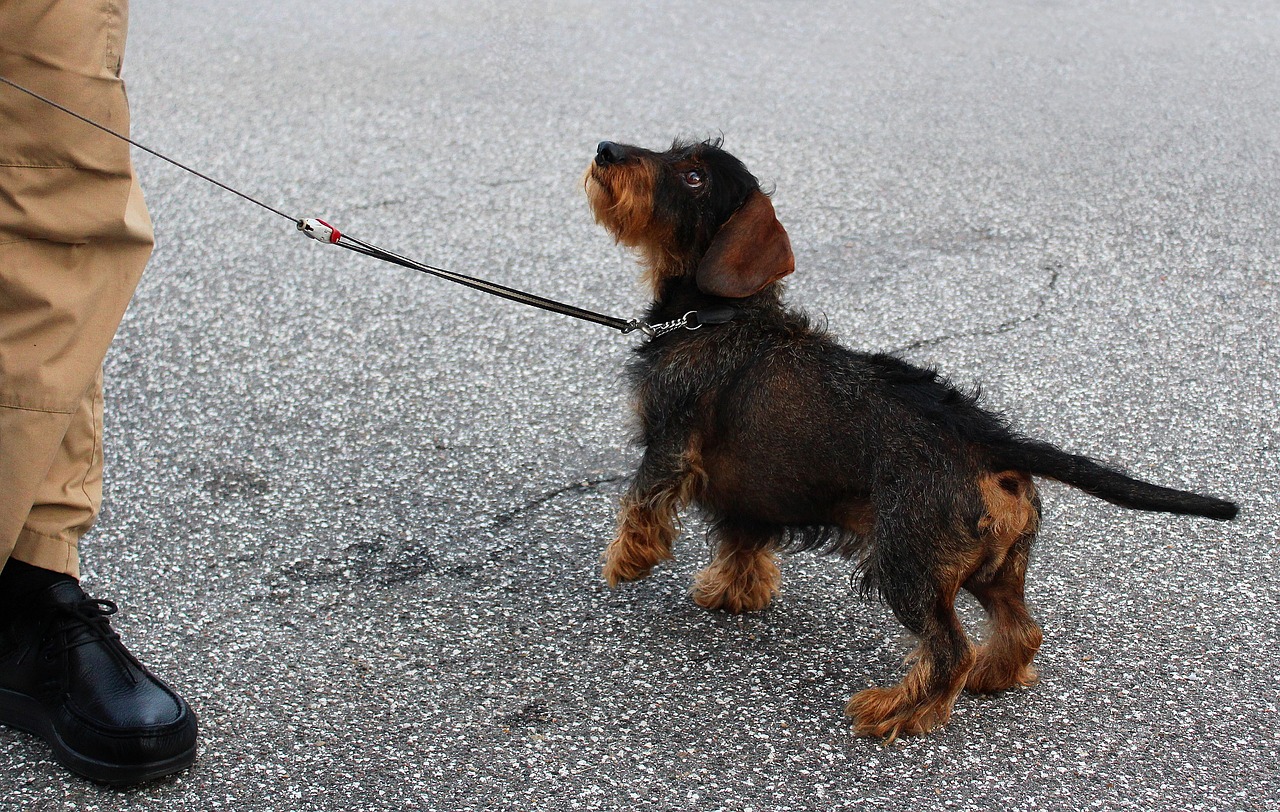
Socialization Opportunities
Providing regular socialization opportunities for your dog is essential in creating a well-adjusted pet. Just like humans, dogs thrive on interactions with different people and environments. Think of it as giving your furry friend a chance to attend a social event where they can meet new friends and learn how to behave in various situations. This exposure can significantly reduce anxiety and excitement, leading to calmer behavior around guests. By introducing your dog to a variety of social settings, you help them develop confidence and learn appropriate greeting behaviors, which can ultimately minimize the jumping issue.
One effective way to enhance your dog's socialization is through controlled introductions. This involves organizing meet-ups with friends or family members who are comfortable around dogs. By creating a manageable setting, you can guide your dog on how to greet others without the chaos that often accompanies unexpected visitors. During these controlled introductions, reward your dog for calm behavior with treats or praise, reinforcing the idea that staying grounded is the way to go.
Moreover, consider implementing gradual exposure techniques. Start by allowing your dog to observe new people from a distance. This distance can help them acclimate to the presence of strangers without feeling overwhelmed. As your dog becomes more comfortable, gradually decrease the distance, giving them the chance to approach and interact at their own pace. This method can be particularly effective in desensitizing dogs to the excitement of guests arriving, ultimately reducing the likelihood of jumping behavior in the future.
Incorporating these socialization practices into your dog's routine not only helps curb jumping but also enriches their life overall. Remember, a well-socialized dog is a happy dog, and happy dogs make for a more enjoyable experience for everyone involved!
- How often should I socialize my dog? - Aim for regular socialization opportunities at least once a week, gradually increasing the frequency as your dog becomes more comfortable.
- What if my dog is fearful of new people? - Start with controlled introductions and maintain a safe distance until your dog feels more confident.
- Can socialization help with other behavioral issues? - Yes! Socialization can improve overall behavior, reducing anxiety and aggression.
Controlled Introductions
When it comes to teaching your dog appropriate greeting behaviors, can make a world of difference. Imagine walking into a room full of excited children, all clamoring for your attention at once. It can be overwhelming, right? Now, picture a calm, orderly gathering where each child waits patiently for their turn to say hello. This is the essence of controlled introductions for your furry friend.
To set the stage for these introductions, it's essential to choose the right environment. Opt for a quiet space where distractions are minimal. This could be your living room or a backyard, but make sure it's a place where your dog feels comfortable and secure. Start by having a friend or family member come over, but before they enter, make sure your dog is on a leash. This not only ensures safety but also gives you control over their behavior.
As your guest arrives, ask them to ignore your dog initially. This means no eye contact, no talking, and definitely no petting—at least not yet! The goal here is to teach your dog that they need to remain calm before they can receive attention. Once your dog settles down, reward them with a treat or praise for their good behavior. This creates a positive association with the idea of waiting patiently.
After a few successful introductions, you can gradually increase the level of interaction. For instance, allow your guest to approach your dog while still maintaining control of the situation. If your dog starts to jump, gently pull them back and remind them to sit. Consistency is key; the more you practice this, the more your dog will learn that calm behavior leads to positive outcomes.
It's also beneficial to incorporate short training sessions into these controlled introductions. For example, you can ask your dog to perform simple commands like "sit" or "stay" before allowing the guest to greet them. This not only reinforces good behavior but also gives your dog a sense of purpose during the encounter.
Remember, the aim is to create a positive experience for both your dog and your guests. Over time, as your dog becomes more accustomed to these controlled introductions, you'll notice a marked improvement in their greeting behavior. They’ll learn that jumping is not the way to get attention, and you’ll enjoy a more peaceful home environment.
- How long should controlled introductions last? Start with short sessions, around 10-15 minutes, and gradually increase the duration as your dog becomes more comfortable.
- What if my dog continues to jump despite controlled introductions? Be patient and consistent. It may take several sessions before your dog fully understands the new behavior.
- Can I use toys during controlled introductions? Yes, but only if your dog is calm. Toys can be a great way to redirect their energy if they start to get too excited.
Gradual Exposure
Gradual exposure is a fantastic technique that can help your dog become more comfortable with new people and situations, ultimately reducing their tendency to jump on guests. Imagine your dog as a sponge, soaking up experiences and learning from them. If they are thrown into a chaotic environment with a lot of unfamiliar faces all at once, it can be overwhelming, leading to that exuberant jumping behavior we often see. Instead, by introducing your dog to new people slowly and in a controlled manner, you can help them build confidence and learn appropriate greeting behaviors.
Start with familiar faces. Invite a friend over who your dog already knows and loves. This not only makes the experience less intimidating for your pup but also allows you to model the desired behavior in a low-pressure setting. You can then gradually increase the number of guests or the level of excitement by inviting more friends or family members over. The key is to keep the introductions calm and positive. If your dog starts to get too excited, take a step back and give them a moment to settle down before continuing.
During these gradual exposures, it's essential to reward calm behavior. Use treats and praise liberally when your dog remains composed. This will reinforce the idea that staying calm is the way to go when meeting new people. Over time, your dog will start to associate guest arrivals with positive experiences rather than overwhelming excitement. Remember, patience is vital here; every dog learns at their own pace, and rushing the process can lead to setbacks.
To keep track of your dog's progress, consider maintaining a simple chart or table that outlines each exposure session, noting the number of guests, the dog's behavior, and any rewards given. This can help you visualize improvements and identify any patterns that may emerge over time.
| Session Number | Number of Guests | Dog's Behavior | Rewards Given |
|---|---|---|---|
| 1 | 1 | Calm | 2 Treats |
| 2 | 3 | Excited but manageable | 1 Treat |
| 3 | 5 | Jumping | 0 Treats |
As your dog becomes more accustomed to these interactions, you’ll notice a significant decrease in their jumping behavior. The goal is to create a positive and relaxed atmosphere for both your dog and your guests. By using gradual exposure, you’re not only teaching your dog how to behave appropriately but also enhancing their social skills, making them a well-rounded member of your family.
- How long does it take for my dog to stop jumping on guests? - The time it takes can vary greatly depending on the dog and the consistency of your training. With patience and regular practice, many dogs show improvement within a few weeks.
- Can I use toys instead of treats for training? - Absolutely! Many dogs respond well to toys as rewards, especially if they are motivated by play.
- What should I do if my dog continues to jump despite my efforts? - If jumping persists, consider consulting a professional dog trainer who can provide personalized guidance tailored to your dog's specific needs.

Maintaining Calm Environments
Creating a calm environment during guest visits is essential for ensuring that both your dog and your guests have a pleasant experience. Think of it like setting the stage for a great performance; if the atmosphere is right, everyone can enjoy the show! When your dog feels relaxed, they are less likely to jump on guests, making for a more enjoyable interaction. So, how can you create this tranquil setting? Let’s dive into some effective strategies.
One of the most effective methods to maintain a calm environment is to engage your dog in exercise prior to visits. Just like humans, dogs have energy that needs to be released. A good romp in the park or a vigorous game of fetch can help tire them out. This way, when guests arrive, your dog is less likely to be bouncing off the walls. Imagine trying to sit still in a room full of exciting distractions; it’s tough! However, if you’ve had a good workout, you’re more inclined to relax. The same goes for your furry friend.
Another important aspect is establishing designated relaxation spots for your dog during guest visits. These spots can be cozy corners with their favorite blanket or a crate that they associate with safety and calmness. When guests arrive, you can guide your dog to these spots, helping them feel secure and less inclined to jump. Think of it as their personal sanctuary amidst the chaos. Just like we all need a little quiet time to recharge, dogs benefit from having their own space to chill out.
In addition to exercise and relaxation spots, it’s crucial to set the tone before guests arrive. Consider implementing a pre-visit routine that includes a brief training session or some calming activities. This could be as simple as practicing commands like “sit” or “stay,” which not only reinforces good behavior but also helps your dog focus their energy positively. You might also want to play some soft music or use calming scents, like lavender, to create a soothing atmosphere. A peaceful environment encourages your dog to be calm, making it less likely for them to jump on guests.
Lastly, it’s essential to remember that consistency is key. Everyone in the household should follow the same calm protocols to ensure your dog receives a unified message. If one person allows jumping while another discourages it, your dog may become confused. Think of it as a team sport; all players need to be on the same page to win the game. By maintaining these calm environments, you foster a sense of security for your dog, which ultimately leads to better behavior around guests.
- What should I do if my dog jumps on guests despite my efforts? Consistency and patience are key. Make sure everyone in your household is on the same page regarding training techniques.
- How long will it take for my dog to stop jumping? The time it takes can vary based on your dog's personality and your training consistency. With dedication, you should see improvement within a few weeks.
- Are there specific breeds that are more prone to jumping? While any dog can jump, breeds with high energy levels, like Border Collies and Labradors, may be more prone to this behavior.
Exercise Prior to Visits
Ensuring that your dog gets ample exercise before guests arrive can be a game changer when it comes to managing their jumping behavior. Think of it as giving them a warm-up before the big event; just like humans, dogs need to burn off some energy to stay calm and collected. If your furry friend is bouncing off the walls, the likelihood of them jumping on guests increases significantly. A well-exercised dog is typically a more relaxed dog, which means fewer surprises for your visitors!
So, how can you effectively tire out your pup before company comes over? Here are some engaging activities you might consider:
- Long Walks: Taking your dog for a long walk can help expend that pent-up energy. Aim for at least 30 minutes to an hour, depending on your dog's breed and energy level.
- Playtime: Engage in a fun game of fetch or tug-of-war. These activities not only provide physical exercise but also mental stimulation, which is equally important.
- Obstacle Courses: Set up a mini obstacle course in your backyard or living room. This can be an exciting way for your dog to use their energy while also learning to navigate through different challenges.
By incorporating these activities into your pre-visit routine, you’re not just making life easier for yourself; you’re also setting your dog up for success. A tired dog is less likely to jump and more likely to greet your guests with a calm demeanor. Plus, it creates a more pleasant atmosphere for everyone involved. Imagine opening the door to a wagging tail and a relaxed pooch instead of a whirlwind of excitement! It’s a win-win situation.
Q: How much exercise does my dog need before guests arrive?
A: It largely depends on your dog's breed and energy level, but generally, 30 minutes to an hour of vigorous activity should suffice.
Q: What if my dog still jumps even after exercising?
A: In that case, you may need to implement additional training techniques, such as positive reinforcement and setting clear boundaries.
Q: Can I use toys to help tire out my dog?
A: Absolutely! Interactive toys can be a great way to keep your dog engaged and active, especially if you're short on time.
Q: How can I create a calm environment for my dog during visits?
A: Establishing designated relaxation spots and maintaining a quiet atmosphere can help your dog feel secure and less likely to jump.
Designated Relaxation Spots
Creating for your dog during guest visits is an essential strategy that can significantly reduce their urge to jump. Think of these spots as your dog's personal oasis, a safe haven where they can retreat when the excitement of visitors becomes overwhelming. By establishing a specific area in your home where your dog feels secure, you can help them learn that it's okay to relax and observe rather than rush towards guests with exuberance.
To set up these relaxation spots, consider choosing a quiet corner in your living room or a cozy area in your bedroom. Equip this space with a comfortable dog bed, some favorite toys, and perhaps a blanket that carries their scent. This setup not only provides comfort but also creates a positive association with the area. It’s like giving your dog a chill zone where they can unwind amidst the hustle and bustle of visitors.
When guests arrive, you can guide your dog to their relaxation spot. Use a calm voice and gentle encouragement to lead them there. Over time, your dog will begin to understand that this is their space for calmness, helping to curb their jumping behavior. It’s important to remember that consistency is key here. If your dog learns that they can retreat to their designated spot whenever guests arrive, they’ll be less likely to feel the need to jump up in excitement.
Additionally, consider using positive reinforcement when your dog chooses to stay in their relaxation spot. A simple treat or praise when they remain calm can go a long way in reinforcing this behavior. This method not only encourages your dog to stay put but also strengthens your bond with them, as they learn that good things happen when they relax.
In conclusion, designated relaxation spots are a simple yet effective way to manage your dog’s jumping behavior. By providing a safe, comfortable space and reinforcing calm behavior, you can transform your dog’s response to guests from chaotic jumping to peaceful relaxation.
- Why does my dog jump on guests? Dogs often jump as a form of greeting or to seek attention. It’s their way of expressing excitement and affection.
- How can I train my dog not to jump? Use positive reinforcement techniques, set clear boundaries, and redirect their energy to more appropriate behaviors.
- What should I do if my dog continues to jump despite training? Be consistent with your training methods, and consider consulting a professional dog trainer for additional guidance.
- Are relaxation spots effective for all dogs? Yes, most dogs benefit from having a designated relaxation area, especially if they tend to get anxious or overly excited around guests.
Frequently Asked Questions
- Why does my dog jump on guests?
Dogs often jump on guests as a way to greet them. It’s their version of a friendly “hello!” They might be excited or trying to get attention. Understanding this behavior is the first step in correcting it.
- What is positive reinforcement in dog training?
Positive reinforcement involves rewarding your dog for good behavior, like sitting calmly when guests arrive. This could be treats, praise, or playtime. It helps your dog learn what you expect from them without using harsh methods.
- How can I set boundaries for my dog when guests arrive?
Establish clear rules about how your dog should behave around guests. Consistency is key! Make sure everyone in your household follows the same rules, so your dog gets a unified message about what’s acceptable.
- What are some effective ways to redirect my dog’s energy?
Teaching your dog to sit or stay when guests arrive can be a great way to redirect their excitement. You can also provide toys or engage in a quick game to help them channel their energy positively.
- How can socialization help reduce jumping behavior?
Regular socialization exposes your dog to different people and environments, which can reduce anxiety and excitement. This exposure helps them learn how to behave appropriately around guests, ultimately leading to calmer interactions.
- What should I do before guests arrive to keep my dog calm?
Make sure your dog gets plenty of exercise before visitors come over. A good walk or play session can help burn off excess energy, making it less likely that they’ll jump when guests arrive.
- Can I create a designated relaxation spot for my dog?
Absolutely! Setting up a quiet area where your dog can retreat during guest visits can help them feel secure and calm. This can be a cozy bed or a crate where they can relax without the chaos of the visit.

